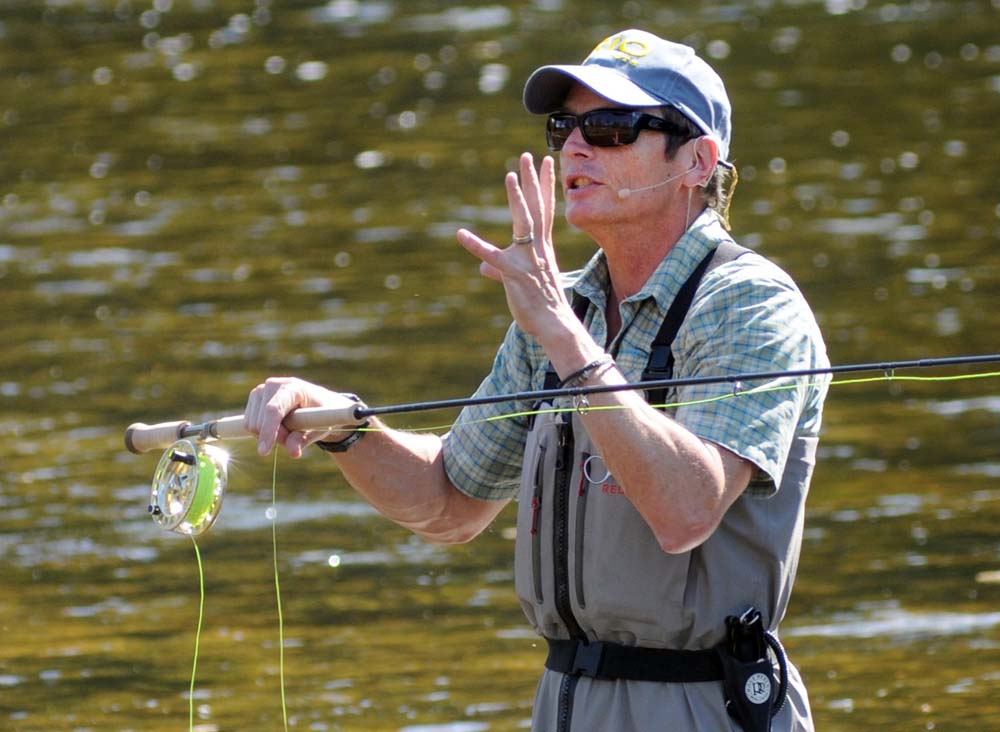
Simon Gawesworth, Rio Products Brand Manager. RIO photo.
There is no single best knot for attaching every hook to every type of line
By Skip Clement
Generally speaking, there are no bad knots that survived decades of use, just a roster of bad knot tyers surviving decades of losing fish.
Beware: There is no single best knot for attaching every hook to every type of line. Fishing knots have more variables than constants, and it is always suspect to say a knot is an x percent knot, but everyone does. In reality, these professed numbers are but a guide and can sometimes be so far off, one from another, that you would think Fox News was behind another of its misinformation reports.
Here’s a short list of some of the more popular leaders to fly knots and their strength relative to the monofilament it is tied to, if available from a reliable testing source, and comments on the flaws or unstated values of those knots experienced over several decades of my best days absent from work without authorizing papers.

Norman Duncan being interviewed by Andy Mill.
This list is not an encouragement to ditch what is serving you well because a familiar knot can only be so if it never fails you. So, for example, assuming IGFA rigged [20-pound test tippet], the Homer Rhodes Knot will never be tested to failure because resistance beyond 20-pounds breaks the tippet, and the Homer Rhodes Knot will not fail [as tested].
The holy grail of fly tying knots has these characteristics; one, it is easy to tie in the worst of conditions, and two, it has a slim profile. Those who destination travel the world to fly fish the best of the best will likely use more than one terminal knot because of the animal size. A #24 dry fly with a Non-Slip Loop Knot is folly personified because a delicate dry fly presentation would be the preference, and the Non-Slip Loop Knot has an unfavorable kerplunk personality.
RIO Products knots tested on calibrated Instron machine [Instron Machine is the premier Materials Testing Machines for Tensile, Fatigue …] with 10-pound tippet material.
Clinch Knot [RIO]:
Broke at 9.4-pounds, or 89% of nylon tied in—[Flies can swim askew – at an angle instead of coming straight off the eye].
Improved Clinch [RIO]:
Broke at 7.4-pounds, or 66% of nylon tied in [bulky knot and too easy to mis-align coils].
Turle Knot [RIO]: [pronounced tur-lee and named after Major W. G. Turle, a 19th-century English fly fisherman].
Broke at 10.5-pounds, or 92% of nylon tied in [using up-eye hook and small flies perfectly – it always swims with the fly attached centered on the eye].
Non-Slip Loop Knot [RIO]:
Broke at 8.4-pounds, or 80% of nylon tied in. You must make sure lines have the same passage direction.
Trilene Knot [RIO]:
Broke at 9.8-pounds, or 99% of nylon tied in. The Trilene is a small knot that barrel seats, and because its tag faces rearward, there is all but a fluke chance of hanging up on algae.
Homer Rhodes Loop Knot [RIO]:
Broke at 8-pounds, or 76% of nylon tied in [popular old-school tarpon knot – easy to tie].
Pitzen Knot (16-20 Knot) [RIO]:
Broke at 9.4-pounds, or 89% of nylon tied in

Illustration by Thom Glace – rainbow trout, brown trout, and brook trout. Used with permission.
More:
Unverifiable testing leader to fly knots using monofilament – relative percent of strength to the nylon it is tied to [various brands].
Palomar Knot:
Extremely easy to tie. It’s considered by some to be the most versatile of all tippets to fly knots.
Davy Knot:
The Davy Knot was created in the 1950s by Davy Wotton when he was competing in the Welsh Fly-Fishing Team. He was experimenting to find a knot that he would be able to tie exceptionally quickly – which makes a lot of sense: less time tying knots equals more time catching fish. Unfortunately, the Davy knot broke at an average strength of 31.6-pounds of pressure. Nevertheless, the Davy Knot probably ties more quickly than any terminal knot. Caution, seating Davy correctly is the only flaw. Also, the Davy is best, #18, and smaller.
Orvis Knot:
Orvis knots break at an average of 36.6-pounds of pressure. The Orvis Knot was invented by Larry Becker, who submitted it in a contest held by the Orvis Company to find the best knot to attach a line to the hook.
Duncan Loop Knot [mis-named as Uni-Knot]:
Norman Duncan developed it independently as a fishing knot in the early 1960s. The knot was popularized as the uni knot by Vic Dunaway, an editor at the Miami Herald, in a 1970 fishing book. The knot is very easy to tie – seats well and some believe it is the only knot they need.
Zip-a-dee-doo-dah
Be wary of claims about the efficiency of knots. When you read that the Zip-a-dee-doo-dah Knot has 97 percent breaking strength — that it retains 97 percent of the strength of the unknotted line — slam on the brakes. Does the author offer any evidence? Or is he merely repeating a figure he read in an article by an author who heard the claim from a friend? Angling literature is full of numbers writers have cribbed (sometimes incorrectly) from one another.
Yes, I’m guilty as well . . .
NOTE: Long story on knots by Art Scheck, A Tangled Subject

